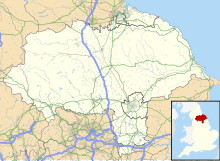Aislaby Quarry
 OS Map 1848-1857; Aislaby is lower middle left | |
| Location | |
|---|---|
| Location | Aislaby |
| County | North Yorkshire |
| Country | England |
| Coordinates | 54°28′01″N 0°41′20″W / 54.467°N 0.689°W |
| Production | |
| Products | Sandstone |
Aislaby Quarry is a sandstone quarry in the village of Aislaby, near to Whitby in North Yorkshire, England. The quarry produces sandstone which has been exported through Whitby to London and South East England.
History
[edit]The quarry workings at Aislaby are 4 miles (6.4 km) west of Whitby,[1] and were known to have been in existence by the 11th century, as the majority of Whitby Abbey was constructed of stone quarried from the area.[2] The West and East Piers at Whitby were faced with 6 tonnes (6.6 tons) blocks of Aislaby stone.[3]
Besides being used for building purposes, some of the stone from Aislaby was used in decorative work such as crosses used in churches.[4] Examples of this stone worked decoratively have been found in churches the area including Whitby Abbey, Lythe, Church of St Mary, Lastingham, and Hovingham.[5][6][7] The Easby Cross, which dates to the early 9th century, has been matched to the same "medium-grained deltaic sandstone traditionally produced in the Aislaby quarries of Eskdale, near Whitby".[8] It is theorised that pack horses took sections of the stone west from Aislaby to the valley of the River Swale, but it is unknown who paid for the cross.[9]
In May 2002, the quarry was re-opened to allow new stone to be quarried to provide repairs for structures which used Aislaby Stone in the first place, such as the east pier at Scarborough.[10] It was again reopened in the 2010s, specifically to supply stone for a renovation programme on the East and West Piers at Whitby.[11] The quarry was registered in 2020 as Eskdale stone, working sandstone from the Saltwick and Cloughton formations of Jurassic sandstone.[12]
Notable structures
[edit]The structures listed below were built with stone quarried at Aislaby (not all structures are entirely of Aislaby stone);
- Admiralty Pier, Dover[13]
- The new Library, Cambridge University[14]
- St Margaret's Church, Aislaby[15]
- Covent Garden[16]
- Easby Cross[9]
- Grinkle Park, Easington[17]
- Guisborough Priory[16]
- Houghton Hall, King's Lynn, the stone was transported to King's Lynn from Whitby by sea[18]
- London Bridge[16]
- Ramsgate Pier[16]
- St Gregory's Minster, Kirkdale (assumed)[19]
- Scarborough North Pier[20]
- Strand Bridge (original Waterloo Bridge)[16]
- Whitby Abbey[21]
- Whitby East Pier[22]
- Whitby West Pier[22]
- Whitby Town Hall[23]
References
[edit]- ^ "Aislaby, Sleights and Ruswarp". Darlington and Stockton Times. 27 July 2012. Retrieved 30 November 2021.
- ^ "Aislaby Quarries". www.heritagegateway.org.uk. Retrieved 30 November 2021.
- ^ Robinson, Francis Kildale (1860). Whitby: its abbey, and the principal parts of the neighbourhood, etc. Whitby: Reed. p. 110. OCLC 504353766.
- ^ Dobson 2006, p. 125.
- ^ "Anglo-Saxon stone carving stolen from Hovingham church". BBC News. 29 June 2015. Retrieved 30 November 2021.
- ^ Lang, James (2001). Corpus of Anglo-Saxon stone sculpture in England. Oxford: Published for the British Academy by the Oxford University Press. p. 17. ISBN 0-19-726256-2.
- ^ Dobson 2006, p. 223.
- ^ "The Easby Cross | Unknown | V&A Explore The Collections". collections.vam.ac.uk. Retrieved 30 November 2021.
- ^ a b Lang, James (2001). Corpus of Anglo-Saxon stone sculpture in England. Oxford: Published for the British Academy by the Oxford University Press. p. 19. ISBN 0-19-726256-2.
- ^ "Seven jobs created as old quarry reopens". The Northern Echo. 14 May 2002. Retrieved 30 November 2021.
- ^ Cooper, Nick; Burdett, Steve; Cooper, Victoria; Rowe, Stewart; Dewe, Graham (September 2021). "The heritage and refurbishment of grade II listed piers at Whitby harbour, North Yorkshire". Proceedings of the Institution of Civil Engineers - Maritime Engineering. 174 (3): 96. doi:10.1680/jmaen.2020.22.
- ^ Cameron, D. G.; Evans, E. J.; Idoine, N.; Mankelow, J.; Parry, S. F.; Patton, M. A. G.; Hill, A. (2020). Directory of mines and quarries (11 ed.). Keyworth: British Geological Society. p. 110. ISBN 978-0-85272-789-8.
- ^ Hall 2013, p. 13.
- ^ Hull, Edward (1872). A treatise on the building and ornamental stones of Great Britain and foreign countries : arranged according to their geological distribution and mineral character, with illustrations of their application in ancient and modern structures. London: MacMillan & Co. p. 258. OCLC 1183522.
- ^ "Aislaby, Sleights and Ruswarp". Darlington and Stockton Times. July 2012. Retrieved 18 January 2022.
- ^ a b c d e Powell 2017, p. 7.
- ^ "New jobs as hotel expands". Evening Gazette. 28 February 2006. p. 6. ISSN 2056-6131.
- ^ Vesey, Barbara (2003). The hidden places of East Anglia : including Essex, Suffolk, Norfolk and Cambridgeshire (7 ed.). Aldermaston: Travel. p. 275. ISBN 1-902-00791-3.
- ^ Rahtz, Philip A. (2021). St Gregory's Minster, Kirkdale, North Yorkshire archaeological investigations and historical context. Oxford: Archaeopress. p. 2. ISBN 978-1-78969-482-6.
- ^ Notes on building construction : arranged to meet the requirements of the syllabus of the Board of Education, South Kensington. Part 3, Materials (5 ed.). London: Longmans, Green and Co. 1901. p. 39. ISBN 978-0-7277-5152-2.
- ^ Watson, John (2015). British and foreign building stones : a descriptive catalogue of the specimens in the Sedgwick Museum, Cambridge. United Kingdom: Cambridge University Press. p. 175. ISBN 978-1-107-50578-0.
- ^ a b Hall 2013, p. 12.
- ^ "Whitby Aislaby Quarries". The Civil engineer and architect's journal. 2. London: Laxton: 373. 1839. OCLC 8416446.
Sources
[edit]- Dobson, Lemont (2006). Landscape, monuments and the construction of social power in early medieval Deira (Thesis). York: University of York. OCLC 500635358.
- Hall, Chris (January 2013). Whitby Conservation Area – Character Appraisal & Management Plan (PDF). scarborough.gov.uk (Report). Archived from the original (PDF) on 31 August 2021. Retrieved 28 May 2024.
- Powell, John (December 2017). Strategic Stone Study; a Building Stone Atlas of North Yorkshire East and York (PDF). bgs.ac.uk (Report). Retrieved 30 November 2021.


